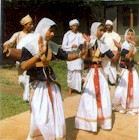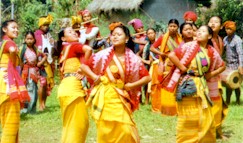|
ASSAM..... Journey to the Green Land
Arts and Handicraft
Literature
Religion
Besides the religious and national festivals observed throughout the
Country, Assam has a large number of colourful festivals of its own replete with fun, music and dances. Assams fairs and festivals
are as varied as its population which comes from different racial origins, both tribal and non-tribal.
The Bihus
The three Bihus or agricultural festivals --- Rongali Bihu in the Spring
to celebrate the beginning of the sowing season; Bhogali Bihu or the harvest festival in January and the Kongali
Bihu which marks the passage of a lean period sometime in November --- are the festivals indigenous to the State and closely
associated with its culture. These are considered to be the national festivals of the Assamese.
Rongali Bihu
Rongali Bihu, also known as Bohag
Bihu because it is celebrated in the Assamese month of Bohag, is the most colourful of the Bihus.
It marks the beginning of the Assamese new year. With Spring in the air, the
mood is buoyant and the atmosphere one of joy and romance. Young boys and girls flirtingly sing and dance to the tunes of
a prolific variety of Bihu songs which are mostly woven around themes of love.
The boys in shirts made of muga silk and the brightly coloured Assamese
towel gamocha tied around their heads, play the buffalo horn (mohar pepa) and beat the drum (bihu dhol),
and the girls dressed in the vividly designed mekhela chaddar, dance with gay abandon in an exotic expression of matters
of the heart. Peculiar musical instruments which accompany the singing and the dancing include the toka, a pair of
clappers made of a split bamboo, and the gagana, a small reed instrument which repeats a single high-pitched note.
Rongali Bihu strikes a common chord among people of all religions, sects and caste as it is celebrated without any secterian
bias.
With the invasion of urban influences, the casual traditional way of celebrating
Rongali Bihu where boys and girls of a village or a number of village used to gather together in a field and dance and sing
away has given way to a more commercial and public manner of celebration where big open-air stages are constructed in different
parts of towns and cities and professional Bihu dance troupes from all over the State are invited to perform. But traditional
Bihu still persists in the villages, and the Bihu atmosphere still pervades notwithsatnding whether it is a big city or a
small village.
Bhogali Bihu
As it is celebrated in the Assamese month of Magh, Bhogali Bihu is also known
as Magh Bihu. This is the harvest festival of Assam, and is more centred around the idea of pleasing ones appetite. On the
eve of the Bihu day, when winter is at its height, people gather around huge bonefires called mejis and feast to
their hearts content. A wide range of Bihu delicacies from the rice-powder pastries stuffed with coconut and til
(pithas) to the sweet balls of coconut and til (larus) are prepared with great care in every home to
serve guests who will come visiting during the season.
Kongali Bihu
Kongali Bihu is perhaps the most solemn of the Bihus and is observed by singing of
hymns near the revered tulsi plant in the flickering light of a small mustard oil-fuelled earthen lamp called the saki.
Kongali Bihu is also known as Kati Bihu because it falls in the Assamese month of Kati.


|
| Nirtya (Dance) of the Vaisnavites |
The Vaisnavites commemorates the birth and death anniversaries of prominent
Vaisnava saints. Hymns are chanted and bhaonas (dramas) are staged. A unique dance form known as the Ojapali is
associated with the worship of the serpent Goddess Manasa. Ambubasi is observed in the Sakta shrines and Sivaratri in Saiva
temples.
The Muslims of Assam celebrate all the festivals of Islam but also have their
own unique form of religious chants known as Zikirs and Jaris which were propagated by the great Muslim saint
of the State, Ajan Fakir. Zikirs and Jaris are a part of the Assamese folk repertoire. Likewise, the Christians, Sikhs, Buddhists
and Jains observe all their religious festivals.

Among what can be termed the pan-Indian festivals, Durga Puja
is celebrated with much fanfare with puja pandals being put up in nearly all the localities of the towns and cities and people
turning out in great numbers for darshan or just to enjoy the mood of festivity.


|
| Bagarumba dance of the Bodo Kacharis |
Among the tribals, the Kacharis observe Bathow Puja which
is equated with the worship of Shiva through animal sacrifices.
The Bodos of the plains have an intricate pattern of indigenous dances associated
with primitive rituals such as the Kherai Puja. The shifung flute which accompanies the dances is
an inherent feature of the Kherai Puja. The Dimasa celebrate Rajni Gobra and Harni Gobra
at the start of the cropping cycle for prosperity and to ward off calamities.
Ali-ai-ligang is the spring festival of the Mishings
observed with jubilant singing and dancing. Po-rag is their harvest festival.
|

